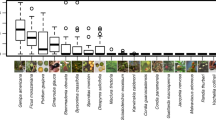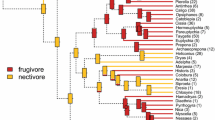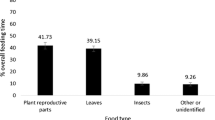Abstract
Fruit and insects are two of the major components of primate diets. Previous investigators have often assumed that the consumption of fruit by primates was unassociated with the consumption of insects. We contend that much of what has been termed fruit-eating by primates involves a significant and deliberate ingestion of insects. The implications of this are discussed.
Similar content being viewed by others
References
Bodenheimer, F. S., 1951.Insects as Human Food. Dr. W. Junk Pub., The Hague.
Boethel, D. J. &R. D. Eikenbary, 1979. Status of pest management programs for the Pecan weevil. In:Pest Management Programs for Deciduous Tree Fruits and Nuts,D. J. Boethel &R. D. Eikenbary (eds.), Plenum Press, New York, pp. 81–120.
Bollard, E. G., 1970. The physiology and nutrition of developing fruits. In:The Biochemistry of Fruits and Their Products,A. C. Hulme (ed.), Academic Press, New York, pp. 387–427.
Bonaccorso, J. F., W. E. Glanz &C. M. Sandford, 1980. Feeding assemblages of mammals at fruitingDipteryx panamensis (Papilionaceae) trees in Panama: Seed predation, dispersal and parasitism.Rev. Biol. Trop., 28: 61–72.
Chagnon, N., 1977.Yanomamo: The Fierce People. Holt, Rinehart & Winston. New York.
Defler, T. R., 1979. On the ecology and behavior ofCebus albifrons in Eastern Colombia: I. Ecology.Primates, 20: 475–490.
Emmons, L. H., 1975. Ecology and behavior of African rainforest squirrels. Ph.D. dissertation, Cornell Univ., Ithaca, New York.
Fogden, M., 1974. A preliminary field study of the western tarsier,Tarsius bancanus. In:Prosimian Biology,R. D. Martin,G. A. Doyle &A. C. Waller (eds.), Univ. Pittsburgh Press, Pittsburgh, pp. 151–166.
Fonseca, G. A. B., 1981. Utilização de exudatos de especies arboreas do cerradão pelo mico-estrela (C. j. penicillata).Resumos do VIII Congresso Bras. Zoologia, 8: 171–172.
&T. E. Lacher, Jr., 1984. Exudate-feeding byCallithrix jacchus penicillata in semideciduous woodland (Cerradão) in Central Brazil.Primates, 25: 441–449.
--, --,T. E. Lacher, Jr., C. Alves & B. Magalhaes-Castro, 1980. Observações preliminares emC. j. penicillata.Pub. Anais do VIII Congresso Bras. Zoologia, pp. 109–110.
Freeland, W. J., 1979. Mangabey (Cercocebus albigena) social organization and population density in relation to food use and availability.Folia Primatol., 32: 108–124.
Freese, C. &J. R. Oppenheimer, 1981. The capuchin monkeys, genusCebus. In:Ecology and Behavior of Neotropical Primates, Vol. 1,A. F. Coimbra-Filho &R. A. Mittermeier (eds.), Acad. Brasil. Cien. Rio de Janeiro, pp. 331–418.
Gittins, S. P. &J. J. Raemaekers, 1980. Siamang, lar and agile gibbons. In:Malayan Forest Primates,D. J. Chivers (ed.), Plenum Press, New York, pp. 63–106.
Goodall, J., 1963. Feeding behaviour of wild chimpanzees.Symp. Zool. Soc. London, 10: 39–47.
Heltne, P. G., J. T. Wojcik &A. G. Pook, 1981. Goeldi's monkey, genusCallimico. In:Ecology and Behavior of Neotropical Primates, Vol. 1,A. F. Coimbra-Filho &R. A. Mittermeier (eds.), Acad. Brasil. Cien. Rio de Janeiro, pp. 149–209.
Herrera, C. M., 1982. Defense of ripe fruits from pests: its significance in relation to plant-disperser interactions.Amer. Naturalist, 120: 218–241.
Hladik, A. &C. M. Hladik, 1969. Rapports tropiques entre végétation et primates dans la forêt de Barro Colorado (Panama).La Terre et la Vie, 1: 25–117.
Hladik, C. M., 1973. Alimentation et activité d'un groupe de chimpanzés réintroduits en forêt Gabonaise.La Terre et la Vie, 27: 343–413.
&A. Hladik, 1972. Disponibilités alimentaires et domaines vitaux des primates à Ceylon.La Terre et la Vie, 1: 149–215.
Hollander, M. &D. A. Wolfe, 1973.Nonparametric Statistical Methods. John Wiley & Sons, New York.
Howell, D. J., 1980. Adaptive variation in diets of desert bats has implications for evolution of feeding strategies.J. Mammal., 41: 730–733.
Janzen, D. H., 1971. The fate ofScheelea rostrata fruits beneath the parent tree: predispersal attack by bruchids.Principes, 15: 89–101.
, 1977. Why fruits rot, seeds mold and meat spoils.Amer. Naturalist, 111: 691–713.
, 1979. How to be a fig.Ann. Rev. Ecol. Syst., 10: 13–15.
Johansen, C., 1971. Insect pests of tree fruits. In:Fundamentals of Applied Entomology,F. R. Pfadt (ed.), Macmillan Publ. Co., New York, pp. 407–438.
Kiltie, P. A., 1980. Seed predation and group size in rain forest forest pecaries. Unpubl. Ph.D. dissertation, Princeton Univ., 170 pp.
Lacher, T., G. A. Bouchardet da Fonseca, C. Alves &B. Magalhaes-Castro, 1981. Exudate-eating, scent- marking and territoriality in wild populations of marmosets.Anim. Behav., 29: 306–307.
, 1984. A study of parasitism of trees by marmosets.Biotropica, 16(3): 202–209.
Lindusky, J. P., 1942. Insect feeding by the house mouse.J. Mammal., 23: 212–213.
Mani, M. S., 1964.Ecology of Plant Galls. Dr. W. Junk Publ., The Hague.
McGlasson, W. B., 1970. The ethylene factor. In:The Biochemistry of Fruits and Their Products,A. C. Hulme (ed.), Academic Press, New York, pp. 475–519.
McInnes, R. S. &P. D. Carne, 1978. Predation of moth larvae by yellow-tailed black cockatoos causing losses in plantations ofEucalyptus grandis in North Coastal New South Wales.Aust. Wildl. Res., 4: 101–121.
Milton, K., 1980.The Foraging Strategy of Howler Monkeys. Columbia Univ. Press, New York.
Nishida, T. &M. Hiraiwa, 1982. Natural history of a tool-using behavior by wild chimpanzees in feeding upon wood-boring ants,J. Human Evol., 11: 73–99.
Oppenheimer, J. R., 1977. Forest structure and its relation to activity of the capuchin monkey (Cebus). In:Use of Non-human Primates in Biomedical Research,M. R. N. Prasad &T. C. Anand Kumar (eds.), Indian National Science Academy, New Delhi, pp. 74–84.
, 1982.Cebus capucinus: Home range population dynamics and interspecific relationships. In:The Ecology of a Tropical Forest,E. G. Leigh,Jr.,A. S. Rand &D. M. Windsor (eds.), Smithsonian Inst. Press, Washington, D. C., pp. 253–272.
Palmer, J. K., 1970. The banana. In:The Biochemistry of Fruits and Their Products,A. C. Hulme (ed.), Academic Press, New York, pp. 65–105.
Redford, K. H. & J. Dorea, in press. The nutritional value of invertebrates with emphasis on ants and termites as food for mammals.J. Zool. (London).
Rijksen, H. D., 1978. A field study on Sumatran orangutans (Pongo pygmaeus Abelii Lesson 1827).Meded. Landbow. Wagen., 78(2): 1–420.
Robbins, C. T., 1983.Wildlife Feeding and Nutrition. Academic Press, New York.
Robinson, J. G., in press. Seasonal variation in use of time and space by the wedge-capped capuchinCebus olivaceus: implications for foraging theory.Ecol. Monogr.
Rosenthal, G. A., 1983. A seed-eating beetle's adaptations to a poisonous seed.Sci. Amer., 164–171.
Rudran, R. 1978.Socioecology of the Blue Monkeys (Cercopithecus mitis stuhlmanni)in the Kibale Forest, Uganda. Smithsonian Contr. Zool., No. 249.
Scott, J. K. &R. Black, 1981. Selective predation by white-tailed black cockatoos on fruit ofBanksia attenuata containing the seed-eating weevilAlphitopis nivea.Aust. Wildl. Res., 8: 421–430.
Shannon, R. E. &J. W. Brewer, 1980. Starch and sugar levels in three coniferous insect galls.Z. ang. Ent., 89: 526–533.
Stephenson, A. G., 1981. Flower and fruit abortion: proximate causes and ultimate functions.Ann. Rev. Ecol. Syst., 12: 253–279.
Struhsaker, T. T., 1978. Food habits of five monkey species in the Kibale Forest, Uganda. In:Recent Advances in Primatology, Vol. 1. Behaviour,D. J. Chivers &J. Herbert (eds.), Academic Press, New York, pp. 225–248.
&L. Leland, 1977. Palm-nut smashing byCebus a. apella in Colombia.Biotropica, 9: 124–126.
Vellayan, S., 1981. The nutritive value ofFicus in the diet of lar gibbon (Hylobates lar).Malays. appl. Biol., 10: 177–181.
Waser, P., 1977a. Figs, wasps and primates.Africana, 6: 23–25.
, 1977b. Feeding, ranging and group size in the mangabey,Cercocebus albigena. In:Primate Ecology,T. H. Clutton-Brock (ed.), Academic Press, New York, pp. 193–222.
Wilson, E. D., K. H. Fisher &M. E. Fugua, 1975.Principles of Nutrition. John Wiley & Sons, New York.
Author information
Authors and Affiliations
About this article
Cite this article
Redford, K.H., Bouchardet da Fonseca, G.A. & Lacher, T.E. The relationship between frugivory and insectivory in primates. Primates 25, 433–440 (1984). https://doi.org/10.1007/BF02381666
Received:
Accepted:
Issue Date:
DOI: https://doi.org/10.1007/BF02381666




